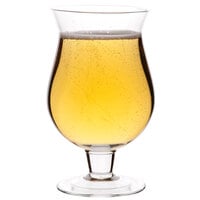If you own a restaurant, brewery, or pub, chances are you've heard of sour beer or even make it yourself. This unique brew is popular among seasoned beer drinkers and novices alike, and its tart flavor and aroma has even brought non-beer drinkers into the fray. Sour beers are notoriously difficult to make and require a long aging period, which discourages some brewers from attempting such an undertaking. However, those who do (and those who purchase sours to sell) reap the rewards of offering these daring and delicious beers. Keep reading to learn more about the history of sour beer, how to make and serve it, and the differences between various kinds of sours.
Shop All Beer Brewing EquipmentWhat is Sour Beer?
Sour beer is a variety of beer that has a distinctively sour taste. It acquires this sour flavor as a result of a unique brewing process that uses wild bacteria and yeast. In contrast, other types of beer use controlled strains of yeast to produce more familiar flavors.
History of Sour Beer
Sour beers have a very long history and are considered the forefathers of many modern beers. Here are a few of the most important things to know about them.
When Was the First Sour Beer Made?

The advent of brewing and drinking beer can be traced to around 4,000 B.C., when all beers were essentially sour beers. At this point, there were many naturally occurring bacteria present in beer, such as lactobacillus (also known as "sour milk bacteria"). These living organisms (often called "bugs") resided in the beer throughout the fermentation process, and their presence produced a sour or funky flavor. As refrigeration and pasteurization technologies evolved and became more prevalent in the mid-nineteenth century, sour beers virtually disappeared as lagers and ales came into prominence. Since the 1970s, however, sours have become increasingly popular among beer drinkers around the world.
Who Invented Sour Beer?
The first sour beers were brewed in Belgium in the early eighteenth century, and there are still breweries in Flanders (northern Belgium) that have been operating for hundreds of years. Many Belgian and German immigrants brought sour beer to the United States after the Civil War, but this style remained difficult to find in America until the 1970s.
What Makes Sour Beer Sour?
Sour beer is sour due to the intentional incorporation of living bacteria like lactobacillus (lacto) and pediococcus (pedio). Lacto converts sugar into lactic acid for lower (more acidic) pH levels and can be found in yogurt and other dairy products. This bacteria is also responsible for giving sour beer its signature tart, crisp flavors. Pedio, on the other hand, contributes unique aromas and flavors lacto might not produce, therefore giving "wild" yeasts like brettanomyces (brett) more to react with. Pedio also produces lactic acid and creates diacetyl compounds for a more intense taste.
All of these bacteria eat sugar like traditional brewer's yeast, but their production of lactic and acetic acids cannot be replicated by regular yeast. Some brewers also add fruit during the aging process to add flavor, spur secondary fermentation, or to contribute microbes naturally present on the fruit's skin.
Is Sour Beer the Same as Beer?

While sours are called "beer," they are actually quite different than other types of beer. Sour beers typically do not use traditional brewer's yeasts (like saccharomyces cerevisiae), and most are not brewed in a sterile environment. In fact, many Belgian brewers still encourage wild yeast strains and bacteria to infiltrate their sour brews by cooling their wort (unfermented beer) outdoors. Additionally, while most beers are aged in metal fermentation tanks, sours are usually aged in wooden vessels, which allows communities of organisms to live in the beer. Interestingly, it took almost 10 years for the first sour beer drinkers to realize the sour taste was intentional and not a brewer error.
How to Make Sour Beer
It is important to determine the specific type of sour beer you will be making before beginning the brewing process. Keep in mind that these basic steps for brewing sour beers may change based upon the specific type of beer you'll be brewing. However, many of the following steps are similar across different sour beer styles.
Mash your grain. Allow it to rest, then sparge until your kettle is full. Sparging is the process of rinsing the grain bed to extract as much sugar as possible without removing tannins from grain husks.
Add a small amount of aged hops to the boil. Adding too much will inhibit the growth of bacteria.
Allow your wort to cool. At this point, pitch the wort into your secondary fermentation vessel and prime it with yeast and the bacteria of your choice. You can either add the bacteria directly, or wait until after it has been primarily fermented with regular brewers yeast. If you prefer, you can choose to add your bugs for a few weeks and incorporate them before beginning secondary fermentation. Some brewers use a coolship to cool the wort, which allows it to pick up wild yeast and bacteria during the cooling process.
Look for certain characteristics as the beer begins to ferment. A head of foamy krausen (yeast and wort proteins) will form on top of the beer and bubble for several weeks. As the wort settles, you may also see a film (called pellicle) on top of the beer that protects the bacteria from exposure to air or harmful substances.
Ferment your beer. This process usually takes 3-18 months, or until the desired level of sourness and lactic acid concentration is reached. At this point, you are ready to bottle your sour beer.
What Yeast is Used to Make Sour Beer?

In most cases, sour beers are not made with traditional brewer's yeasts like saccharomyces cerevisiae. Instead, wild yeasts like brettanomyces are used because they provide the sour notes and unique flavors pure yeast cannot. Brett slowly ferments beer and is responsible for what brewers refer to as "funk." While lagers and ales ("clean" beers) are fermented with a pure culture of brewer's yeast, the phenols in brett create the signature taste and aromatic "funk" present in sour beers.
What is the Average Alcohol Content of Sour Beer?
On average, most sour beers are somewhere between 3-5% alcohol by volume (ABV), although some may be as low as 2% or as high as 8-9%. The alcohol content largely depends upon the style of sour and the conditions under which it was brewed.
Different Types of Sour Beer
There are a wide variety of sour beers available today, many of which have their origins in Belgium and Germany. However, there is also an increasing amount of American-made sours produced each year by craft breweries. The main types of sour beers are described below:
- American wild ales: This is a catch-all category for sour beers originating in America. There are no specific brewing rules concerning American wild ales.
- Berliner weisse: Originating in Berlin, these sours are typically flavored with fruit syrups to balance their tart flavor.
- East Flanders brown ale/Oud bruin: These sours come from the Flemish region of Belgium and are not aged in wood. As a result, brewers use cultured yeasts to impart sour flavors.
- Gose: Goses are from Goslar, Germany, and usually incorporate coriander and salt during the brewing process. These beers are made sour from brewers inoculating the wort with lactic acid before primary fermentation.
- Gueuze: This sour is a specific type of lambic made by blending young and old batches of lambics and then bottling them for secondary fermentation. Gueuzes frequently incorporate cherries or other sweet fruits during secondary fermentation to temper their tartness.
- Lambic: Lambics originated in the Pajottenland region of Belgium (including Brussels) and are usually spontaneously fermented in open air. Lambics are frequently blended with other batches or secondarily fermented with fruit.
- West Flanders sour red ale: Originating in the Flemish region of Belgium, these brews are descendants of English porters. West Flanders sours are typically fermented with traditional brewer's yeast, then placed in oak barrels to mature and age alongside bacteria.
Must-Try Sour Beers

While there are many delicious sour beers, here are a handful of our favorites:
- Russian River Brewing Company (Santa Rosa, California) Supplication, an American wild ale
- Dogfish Head Craft Brewed Ales (Milton, Delaware) Festina Pêche, a neo-Berliner weisse
- Deschutes Brewery (Bend, Oregon) The Dissident, an East Flanders Oud bruin
- Victory Brewing Company (Downingtown, Pennsylvania) Kirsch Gose, a gose
- Lindemans Brewery (Vlezenbeek, Belgium) Oude Gueuze Cuveé René, a gueuze
- Cantillon Brewery (Brussels, Belgium) Fou' Foune, a lambic
- Green Flash Brewing Company (San Diego, California) Cellar 3 Flanders Drive, a West Flanders sour red ale
How to Store Sour Beer
Sour beer should be stored between 45-55 degrees Fahrenheit. If you cap your sour beers, you should store them upright. If they are corked, however, it is recommended that you store them on their sides. This keeps the corks moist and prevents air from getting into the bottle.
How to Serve Sour Beer
Serving temperatures for sour beers vary depending on the specific varieties. Berliner weisse should be served between 40-45 degrees, while others (including sour ales, lambics, and gueuzes) taste best between 50-55 degrees.

Suggested Glassware for Serving Sour Beer
Sour beer can be served in a variety of different glasses, but your best bet is the tulip. This glass allows you to generate a complex aroma from the head of the beer and also allows the brew to breathe, which is especially important when enjoying a sour. Depending upon your (or your customer's) preference, however, you can also serve sours from snifters, tumblers, and oversized wine glasses. If you're serving these as a part of a tasting flight, make sure they come after any heavy or dark beers.
Food Pairings for Sour Beer
Sour beer goes well with a variety of different foods, but its uniquely tart flavor and aroma specifically compliment the following dishes:
- Spicy foods like chili or fajitas
- Fatty cuts of beef
- Sausage and other salty, cured meats
- Deep-fried foods like french fries or onion rings
- Assertive cheeses like sharp cheddar, blue, and goat
- Mussels, clams, and oysters, especially when served with lemon juice and drawn butter
- Omelets and other egg dishes
From lambics to goses and everything in between, sour beers are one of the most unique and refreshing options available in the world of beer. Their low alcohol content is also an attractive feature to establishments looking to sell a lot of beer and customers in search of an easy-to-drink beer that goes down easy. By teaming up exotic yeast with beneficial bacteria, sour beers produce a taste explosion that will leave patrons puckering up and coming back for more.



